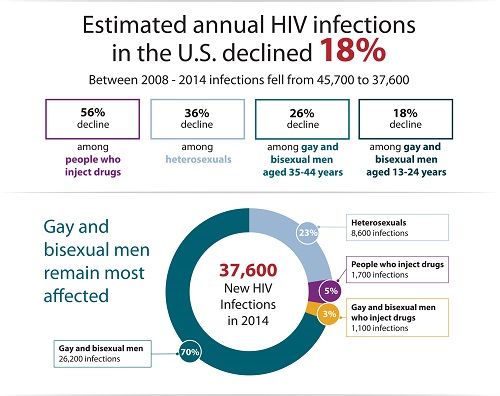HIV Infections Increasing Among Young Gay & Bisexual Men Despite Overall National Decrease
The Centers for Disease Control and Prevention is reporting that annual HIV infections declined from 2008 to 2014, but this decrease was not seen across all groups.
A recent report from the Centers for Disease Control and Prevention (CDC) is showing that annual HIV infections in the United States dropped from 45,700 in 2008, to 37,600 in 2014; an 18% decrease. The report was recently presented at the Conference on Retroviruses and Opportunistic Infections (CROI) in Seattle, Washington. Despite this progress, the CDC found that the decrease “was not the same among all populations or areas of the country.” Among 35 states and Washington, DC, annual infections of HIV either decreased or remained stable.
This recent analysis also showed a decrease in infections from 2008 to 2014 among different transmission routes (see Graphic):
Estimated New HIV Infections in the United States by Transmission Route

The researchers believed that efforts towards helping individuals know their status, as well as ensuring that they are virally suppressed through the use of early treatment with antiretrovirals led to the decline in annual HIV infections. The availability of pre-exposure prophylaxis (PrEP) may have also led to this decline.
Jonathan Mermin, MD, director of CDC’s National Center for HIV/AIDS, Viral Hepatitis, STD, and TB Prevention was quoted in a press release as saying, “The nation’s new high-impact approach to HIV prevention is working. We have the tools, and we are using them to bring us closer to a future free of HIV. These data reflect the success of collective prevention and treatment efforts at national, state and local levels. We must ensure the interventions that work reach those who need them most.”
Eugene McCray, MD, director of CDC’s Division of HIV/AIDS Prevention added to this, stating, “Maximizing the power of these new prevention tools in conjunction with testing and education efforts, offers the hope of ending the HIV epidemic in this nation. Science has shown us the power of HIV treatment medicines in benefitting people with and without HIV.”
It is important to note that progress was not seen in all groups. According to the press release, “Gay and bisexual men were the only group that did not experience an overall decline in annual HIV infections from 2008 to 2014,” which could be because, “reduced infections among whites and the youngest gay and bisexual men were offset by increases in other groups.” Instead the results remained relatively stable at 26,000 infections per year among, “gay and bisexual men overall and about 10,000 infections per year among black gay and bisexual men.” Still these numbers are a positive sign after more than a decade of increases in these populations.
On the other hand, the CDC saw a concerning increase in HIV infections in certain ages and ethnicities:
- 35% increase among 25- to 34-year-old gay and bisexual males (from 7,200 to 9,700);
- 20% increase among Latino gay and bisexual males (from 6,100 to 7,300).
According to the press release, “These data also show regional disparities in southern states, which are home to 37% of the US population but accounted for 50% of estimated infections in 2014. Future analyses will examine racial and ethnic disparities of annual HIV infections.”
Another area concern is among those individuals who inject drugs. Although the data shows a decrease in new infections of HIV in this population, according to Dr. Mermin, “The opioid epidemic in our country is jeopardizing the dramatic progress we’ve made in reducing HIV among people who inject drugs. We need to expand the reach of comprehensive syringe services programs, which reduce the risk of HIV infection without increasing drug use, and can link people to vital services to help them stop using drugs.”
To continue the progress towards decreasing HIV infection rates in the United States, the CDC is implementing a “High-Impact Prevention (HIP) approach.” This approach “involves delivering scientifically proven, cost-effective, and scalable interventions, with particular attention to the most heavily affected populations and geographic areas.” According to the press release, this will involve working with national, state, and local partners to ensure:
- HIV testing is simple, available and routine;
- People living with HIV get care and treatment, starting the day they are diagnosed;
- And that people who are not infected with HIV have prevention information and tools, such as comprehensive syringe services programs and PrEP, as indicated.
More information on the progress made towards decreasing HIV infections and the CDC’s prevention efforts is available at the CDC website.
